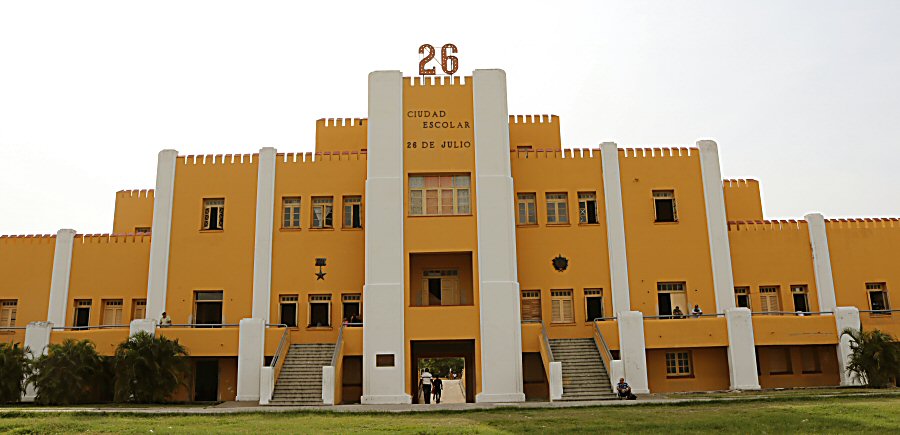Museo Histórico 26 de Julio is located on the Avenida Moncada at the intersection with the Trinidad street.
every day, 24 hours


Before the revolution Moncada
barracks was the headquarter of the military force under the
command of the bloody dictator Fulgencia Batista in Santiago de
Cuba. It was named after the General Guillermón Moncada, a hero
of the War of Independence. Its im portance
was that it was the second largest garrison in the country,
occupied by about 400 soldiers.
portance
was that it was the second largest garrison in the country,
occupied by about 400 soldiers.
On July 26, 1953, the barracks was attacked by a group of rebels led by Fidel Castro. This armed assault is widely accepted as the beginning of revolutionary movement.
In 1960, Fidel Castro himself drove the bulldozer to
demolish the outer walls of the barracks, and 3 weeks later the
barracks was converted into a school that took the name Ciudad Escolar 26 de Julio. In 1967, a certain part of the former
barracks was devoted to a museum to exhibit the facts related
with the assault.
The bullet holes visible on the
façade are not original.
The museum consists of seven
exhibition rooms.
In the room 1, the theme is the
history of the fortress since its construction in 1859. In a
showcase you can see the replica of the sword of José Guillermo
Moncada Veranes, the jail record of Antonio Guiteras that was
imprisoned here in 1931.
In the room 2, a meticulous scale
model details the three places attacked by the rebel groups: the
Moncada barracks, the civil hospital (Hospital Saturnino Lora)
and the courthouse (Palacio de Justica). The portrait photos of
61 rebels (6 of them fallen during the action, 45 of them
murdered later in Santiago de Cuba, and 10 of them killed in
Bayamo) are demonstrated in the room. In the showcase you can
see the bloodied uniforms and belongings of the rebels, as well
as the weapons used in the assault. Photos show the creation of
the movement headed by Fidel Castro, the military preparation
before the assault, the places where the young rebels practiced
shooting, and the Siboney farm where the rebels stayed before
the attack.
The room 3 was one of the torture
rooms formerly. Therefore, the showcase in the room is full of
instruments of torture. You can see the cell where the detainees
were temporarily kept before the torture sessions.
The room 4 focuses on the hearings in
1953. At the photos you can see the rebels in the prison
Presidio Modelo in Isla de Pinos (today Isla de la Juventud),
their release from the prison, and their days in exile in
Mexico.
In the room 5, the portrait photos of
the 82 rebels that arrived in Granma yacht in Santiago de Cuba,
are shown on a panel. A replica of the yacht is placed in the
middle of the room.
In the room 6, the subject of the
clandestine struggle is handled, focusing on the armed uprising
in Cienfuegos. You can see also the weapons and helmets captured
by the Batista’s soldiers, and the sayuela (female underwear
that covers the lower part of the body or worn under the skirt
in Cuba) used by the Cuban women to hide weapons, bullets,
propaganda material and other necessary items on the Sierra
Maestra mountains.
In room 7, you can see the painting
made by 15 Cuban plastic artists as a tribute to the 61 rebels
killed due to the armed action against the Moncada barracks. The
historical evolution of the struggle from Grito de Yara in 1868
until the Moncada attack in 1953 has been reflected on this
painting, entitled “Absuelto por la Historia / absolved by
history”. A vest worn by José Martí during his visits to the
Caribbean countries, and a Winchester rifle as a symbol of the
weapons used by the rebel army on the Siearra Maestra mountains
are exhibited in the room. In the final display cabinet, you can
see a weapon, carved with the national flag and the inscription
“Vale más morir de pies a vivir de rodillas / It’s better to die
on your feet than to live on your knees”.